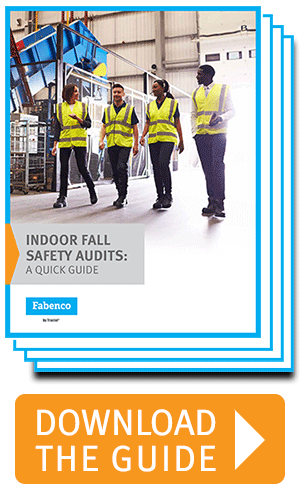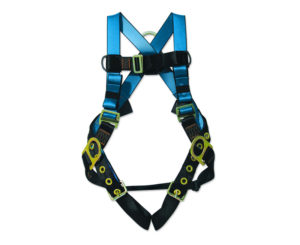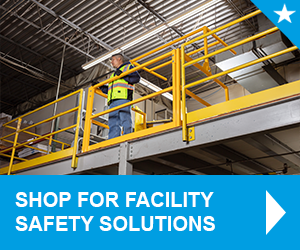
Having the right safety precautions in place isn’t just good for your employees, it’s good for your business. Considering that the costs of non-compliance can sky-rocket (and quickly, to boot), being anything less than fastidious about safety can debilitate your otherwise reputable construction company.
According to the latest data, about 10.3 million workers were employed in construction — and it’s no secret that falls are a major occupational hazard in the industry. From framing out higher stories to window and skylight work, to roof maintenance, and everything in between, a sure foot is just as valuable as skilled hands. Since no one’s perfect, the best way to keep everyone healthy and happy (including your stakeholders) is to enforce OSHA safety regulations, no matter what. When working at height that likely means using a fall protection harness and a safety lanyard.
Working At Height Situations
Some common working at height situations construction workers find themselves in include:
- Building framework
- Erecting and working on scaffolding
- Roof work and roof maintenance
Demolition work
- Painting
- Welding
- Window and skylight work
- HVAC work
You can see why using a fall protection harness and lanyard is a wise choice. Granted, tradespeople employed in these areas should be familiar with the safety issues at stake, and they may even have a solid foundation of OSHA requirements and best practices. Unfortunately, accidents happen and even the best of the best can make a mistake. That’s why it’s important to stay vigilant, no matter who experienced your staff is.
Working At Height Hazards
Aside from the obvious hazard of falling, there are a few other things that can lead to accidents when working at heights. Even if your team is using personal protection equipment like safety harnesses and lanyards, here are a few dangers you might not have considered:
- Poorly constructed scaffolding
- Weak or compromised lanyard anchor points
- Insecurely attached loads
- Uncovered holes or openings
- When outdoors, inclement weather and debris
What OSHA Requires
Different jobs require different precautions and fall arrest systems, but OSHA requires any job that exposes workers to a fall of six feet or more to implement one or more of three primary fall prevention systems:
Safety Nets
A great option, but keep in mind, OSHA has very specific requirements for safety net usage. They must be installed in such a way that they not only prevent contact with the lower level or any objects on the surface. They also must be placed no more than 30 feet from the worker’s surface, and the mesh openings cannot exceed 36 square inches. When a safety net is in place, OSHA expects them to be inspected for wear, tear, and damage at least weekly. To test the efficacy of your safety net, OSHA says to drop a 400-pound bag of sand 28-32 inches in diameter into the net from the highest surface at which employees are exposed to fall hazards, but not from less than 42 inches above that level.
Guardrails
According to OSHA, guardrails should be 42 inches high and able to withstand the force of 200 pounds. If there is no wall or parapet at least 21 inches high protecting the edge, midrails or screens should be installed between the top of the guardrail and the working surface to prevent falls. Learn more about guardrail fall protection here.
Personal Fall Arrest Systems
There are several requirements that OSHA has instituted regarding personal fall arrest systems:
Attachment – The attachment of the harness should be at the center of the worker’s back, near shoulder-level or above the head.
Fall Protection Harness – After body belts were determined to put workers at risk of internal injuries after stopping a fall, OSHA began requiring body harnesses that reduce stress on the body from the force of a fall.
Safety Lanyard – The mesh of a safety lanyard is required to have a minimum breaking strength of 5,000 pounds and not be at risk of being cut or damaged. The webbing of lanyards must be made from synthetic fibers. The combination of harnesses and lanyards increases their safety efficacy.
Anchorages – Must be capable of supporting at least 5,000 pounds. Anchorages must be separate from any other anchorages used to support/suspend platforms.
Additionally, OSHA offers these tips for using personal fall arrest systems safely:
1. Ensure that personal fall arrest systems will, when stopping a fall:
- Limit the maximum arresting force to 1,800 pounds.
- Be rigged so an employee can neither free fall more than 6 feet nor contact any lower level.
- Bring an employee to a complete stop and limit maximum deceleration distance to 3½ feet.
- Have sufficient strength to withstand twice the potential impact energy of a worker free falling a distance of 6 feet, or the free fall distance permitted by the system, whichever is less.
2. Remove components from service immediately if they have been subjected to fall impact, until they can be inspected by a competent person and deemed undamaged and suitable for use.
3. Promptly rescue employees in the event of a fall, or assure that they are able to rescue themselves.
4. Inspect systems before use for wear, damage, and other deterioration, and remove defective components from service.
5. Do not attach fall arrest systems to guardrail systems or hoists.
6. Rig fall arrest systems to allow movement of the worker only as far as the edge of the walking/working surface when used at hoist areas.
Enforcing the Requirements
Of course, implementing these and other safety measures won’t do any good if they aren’t used or enforced. Why wouldn’t an employee use their safety systems? There are a few reasons. Maybe the job will “just take a minute.” Maybe the equipment is uncomfortable to wear or hinders their performance. Or, maybe it’s just worn out and no one’s mentioned it.
In any case, as a manager, you need to make sure safety isn’t just a priority. It needs to be part of your workplace culture. Every employee working at height — no matter for six minutes or six hours — needs to use fall protect every single time. (Wondering if your company needs a safety audit? Read our Five Major Signs Your Facility Needs A Safety Evaluation.)
Fabenco, The Safety Gate Company is passionate about providing high-quality, American-made construction safety equipment. We have a huge variety of OSHA-compliant harnesses and lanyards that can help keep your worksite and employees safer. Contact us today to find out more about our safety products.





 Demolition work
Demolition work

